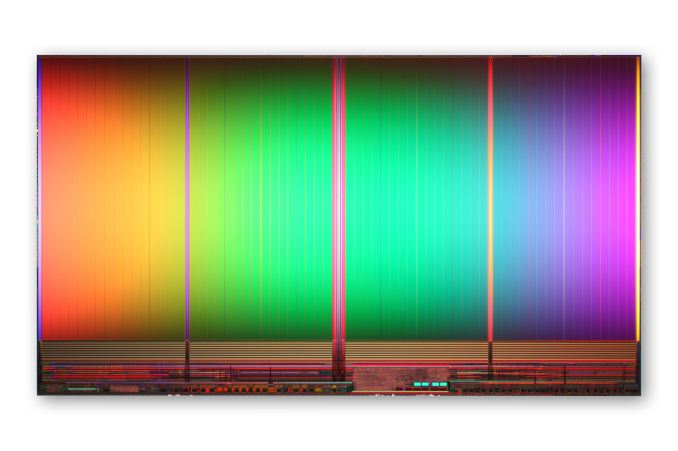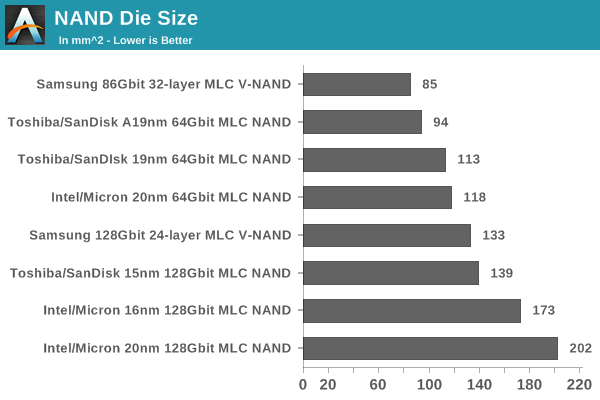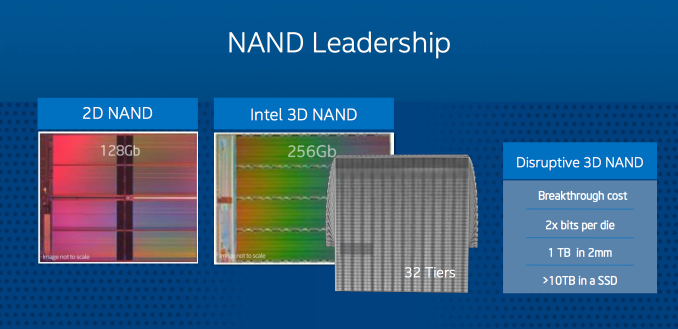Intel's 3D NAND to Ship in H2'15: 256Gbit Die & 32 Layers
by Kristian Vättö on November 25, 2014 5:20 AM EST
Last Thursday in its annual Investor Meeting Intel revealed the first details of its 3D NAND technology and announced that it will begin the shipments of 3D NAND in the second half of 2015. While Intel's investment in 3D NAND hasn't been a secret, the company has been relatively quiet about any specifics and the vital specs such as the number of layers and die capacity have remained unknown. In Thursday's webcast, Rob Crooke, Senior VP and General Manager of Intel's non-volatile memory group, disclosed that Intel's first generation 3D MLC NAND die will be 256Gbit (32GB) in capacity and will consist of 32 layers. The technology also enables a 384Gbit (48GB) TLC (3-bit-per-cell) die as we have learned over the years.
Intel claims that its 3D NAND is the most cost effective on the market and bases this on the fact that its die is 256Gbit whereas Samsung's is only up to 128Gbit at the moment. I'm not sure if I buy Intel's claim because while it's true that a higher capacity die results in higher array efficiency (i.e. peripheral circuitry takes less area), Samsung consciously went from a 24-layer 128Gbit MLC die to a 32-layer 86Gbit MLC die. In other words, Samsung could have upped the die capacity to ~170Gbit by just adding the extra layers, but the company chose to go with a smaller die instead. Smaller capacity dies have advantages in performance (higher parallelism) and applicability because eMMC/microSD devices have very strict die size constraints, so that might be a part of the reason why Samsung's strategy is so different from Intel's and Micron's.

As the graph above shows, Intel's/Micron's NAND dies have historically been larger than the competitors', so the die capacity alone isn't enough to dictate whether Intel's 3D NAND is more cost efficient than Samsung, especially because both have 32 layers. Unlike Samsung, Intel didn't reveal the lithography that is used to manufacture the 3D NAND, but I would say it's safe to assume that the lithography is in the order of 30nm or 40nm because the whole idea of 3D NAND is to move away from multi-patterning to cut costs and with today's technology the smallest pitch of single-patterning is somewhere between 30nm and 40nm. Either way, it will be very interesting to see how Intel's 3D NAND stacks up against Samsung's because there are also some structural differences that affect the production cost as well as performance and endurance, but I'll save the structural analysis for a future article.
Intel said that 3D NAND technology will enable +10TB SSDs in the 'next couple of years', but it wasn't clear whether that is with first generation 3D NAND or some later generation with more layers and higher die capacity. Currently Intel's lineup tops out at 2TB (P3700 & P3600) with a 128Gbit die, so the 256Gbit die alone isn't enough to bring the capacities above 10TB. With effective controller development it should certainly be possible to build a 10TB SSD with a 256Gbit die, although I'm still inclined to believe that Mr. Crooke was referring to second or third generation 3D NAND with his statement.
Similar to Intel's previous NAND efforts, 3D NAND has been jointly developed with Micron and will most likely be manufactured in the co-owned Utah plant as Intel sold its share in other fabs a couple of years ago. Interestingly enough, Mr. Crooke said that they also have the ability to bring 3D NAND production to an Intel fab, although to me that sounded more like a statement of technological possibility rather than a hint of future strategy. I wouldn't rule it out, though, but like Mr. Crooke said in the Q&A, Intel needs to have significant competitive advantage for it to make sense. In the past Intel's NAND technologies have generally been slightly ahead of the rest of the industry, but at least as of now Intel doesn't seem to have any substantial advantage in 3D NAND technology as Samsung is already shipping a 32-layer die and will likely ship a 48-layer die before Intel ships its 32-layer product.
All in all, we'll likely get more crumbs of information as the second half of 2015 gets closer. Given Intel's recent SSD strategy, I expect 3D NAND to first find its way to enterprise-class SSDs, but we'll see soon enough.












58 Comments
View All Comments
The Von Matrices - Tuesday, November 25, 2014 - link
4GB drives are not affordable? It's extremely easy to find USB flash drives with double the capacity, 8GB, for under $5.mkozakewich - Tuesday, November 25, 2014 - link
"I'm not sure if I buy Intel's clam..."Oh baby, yes.
bill.rookard - Tuesday, November 25, 2014 - link
The thing I like about the V-NAND (or 3D-NAND, whatever the particular fabber calls it), the the sheer write endurance enabled by the larger process that these chips are fabbed on. The rush to smaller process just had too many tradeoffs with regards to speed and durability that I just didn't understand.Plus, the increased density enabling larger SSD's is great. I really hope they start releasing some high capacity SSD's (2+ TB). Using those in my media server would give me such piece of mind that I'd probably not even enable RAID.
MrSpadge - Tuesday, November 25, 2014 - link
"The rush to smaller process just had too many tradeoffs with regards to speed and durability that I just didn't understand."The smaller processes make them cheaper, whereas endurance is stil fine for regular use and performance is limited by SATA3 anyway. From my point of view that's easy enough to understand. Don't make everyone pay more (demand more expensive SSDs manufactured with bigger structures) because you don't trust the endurance. If you really need more endurance, simply choose the more expensive drives available today.
And using SSDs for bulk media storage? Well.. that's pretty much throwing money out of the window. And especially there you don't need write endurance: you're putting the media collection there once and that's it. And not using RAID will not protect you from loosing an SSD controller, which is a far more typical failure than wearing out the NAND.
jjj - Tuesday, November 25, 2014 - link
In February or so Micron should have it's winter analysts conference and we might get some details then.Laststop311 - Tuesday, November 25, 2014 - link
I'm still waiting for sata express drives. We have had the connector available for like at least a year i want to say and still no drive to connect to it. And Samsung is still the only vendor I will buy an ssd from. Samsung has complete vertical integration of the entire SSD product. They alone control the nand, the dram cache, the controller, the firmware. This is why their ssd's perform so well. They can tweak everything to synergize extremely well together. You can't beat that. I love my 256GB samsung 840 pro and I would like to get a 1TB samsung 860 pro sata express SSD when they finally start releasing some sata express drives (don't know what it will actually be called but you get the idea). I like to keep 25% of the SSD drive free to keep performance nice and maxed out and I'm running out of room.asmian - Tuesday, November 25, 2014 - link
Hmmm. After the EVO firmware debacle I'm steering clear of Samsung for a while, especially for new NAND tech - early adopter syndrome can be too costly even if it looks cheaper on paper.Laststop311 - Wednesday, November 26, 2014 - link
debacle? it wasn't even that bad they admitted problem and fixed it. And if you werent cheap and bought the pro editions it didn't affect youasmian - Wednesday, November 26, 2014 - link
It's nothing to do with being "cheap"! Not everyone wants, needs or can afford "Pro" editions. You make it sound like a snobbish choice, rather than people making informed decisions on how to prioritise their spending. The EVOs are drives designed as mass-market consumer items, that got rave reviews and recommendations from just about everyone, including here at AT, for their ground-breaking price/performance ratio (until the MX100 came out, anyway). This is the new battleground for companies as we all wait for cheaper and more dense NAND tech so that price/GB can drop further the way we all want.The fact that they screwed the EVO up by not testing or validating their firmware properly in a rush to market with the cheap TLC design is concerning. Admitting they had a problem doesn't excuse the original failing. That's why I disagree strongly with the original poster that ONLY Samsung are trustworthy SSD vendors, something that's patently absurd in light of the EVO problems. They may not be unreliable on the scale of OCZ as was, but they still have to be called out on this, especially when they are likely to be the first out with a 3D NAND device that everyone will be expecting very big things from. It's even more difficult to risk being an early adopter if problems only start to show up months after first usage, as was the case with the EVO.
Just because you were lucky to be able to afford something MUCH more expensive, don't discount the bad experience of the many that bought EVOs expecting a base reliability which the vast majority of current SSD products share now (after the numerous issues with OCZ, SandForce etc. in the past which badly damaged this market) but who got burnt on the back of the EVO's hype in the press, and the assumption that Samsung couldn't screw up on something like this.
Laststop311 - Wednesday, November 26, 2014 - link
And the fixed the bug so everyone with an evo drive is having no problems. It was a slight inconvenience people had for a couple months and samsung admitted their problem and fixed it promptly. Everyone currently using an evo drive is running great now with no problem. If they didnt fix it I could see where u are coming from but they fixed it therefore the issue you are speaking of is non existent.